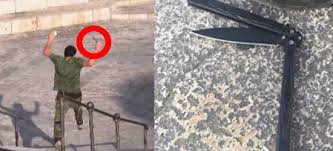Two weeks after the New York Times absurdly characterized a Palestinian assailant’s butterfly knife as a “Boy Scout” knife, the newspaper has removed the reference and published a correction.
The original language of Jodi Rudoren’s Oct. 27 story, referring to an attempted attack that was stopped by alert Israeli security forces, stated:
“He was not carrying a knife, I saw everything,” a [Palestinian] witness insisted. “If they show a knife, they planted it.”
The Israeli police soon published a photo of a pocketknife, the kind Boy Scouts use, next to the slain teenager.”
The gratuitous aside about a “Boy Scout” knife has been removed from the story, and an awkwardly detailed correction now explains:
Correction: November 10, 2015An earlier version of this article referred imprecisely to the knife in the Israeli police photo. It is a butterfly knife, which is traditionally used as a weapon. The Boy Scouts of America does not explicitly ban such knives; it endorses pocketknives for general use, and does not sell butterfly knives in its official Scout shop. Butterfly knives are legal in some states, and knife policies are set by individual troops, so it is possible, though unlikely, that some troops approve them. But the knife pictured is not typically “the kind Boy Scouts use.”
Although the most absurd (and telling) error has now been corrected, the worst distortion remains unaltered. The newspaper characterizes the incident as an unknowable “he said/she said”: Was he holding a knife, or was he shot in cold blood? A supposed witness says there was no knife and predicts Israel will show a photo of a “planted” knife, and, lo and behold, Israel indeed shows a photo of a knife next to his body. Who’s to say what really happened?
 But what really happened is a matter of empirical truth. The assailant was caught on video by an MSNBC cameraman while wielding the knife and charging at Israelis. That video was widely publicized. The “witness” was provably wrong, but the New York Times, which in three separate articles described his weapon as nothing more than an Israeli claim, and in two separate articles credulously relayed charges that the knife was planted, declined to let readers know the key facts.
But what really happened is a matter of empirical truth. The assailant was caught on video by an MSNBC cameraman while wielding the knife and charging at Israelis. That video was widely publicized. The “witness” was provably wrong, but the New York Times, which in three separate articles described his weapon as nothing more than an Israeli claim, and in two separate articles credulously relayed charges that the knife was planted, declined to let readers know the key facts.We continue to urge the newspaper to publish a clarification informing its readers, for the first time, that despite conspiracy theories to the contrary, there is independent footage of the attacker holding a knife when he was shot.
